




Sterile Containers to Receive the Hydrosols at the Still
The average flow of a distillate is three to five literes per hour, although this obviously varies from plant to plant, it therefore takes from four to seven hours to fill a twenty-liter container. If the still is an open space, everything from insects to dust to plant parts and, of course, bacteria can enter the jug along with the hydrosol during this time.. Even if the container is sterile to start with --and your hydrosol is sterile by nature--by the time a lid is put on the jug, the contents are no longer guaranteed sterile. Even a modern, clean factory environment will have dust and airborne materials, if only from the kilos of plant material being moved around.
But how bad is this, It depends on where you are and what you are distilling. Some hydrosols seem more prone to bacteria growth than others. But one thing is certain: how the waters are treated once they are bottled is a key factor in their life preservation.In my experience hydrosols that are produced in the middle of the desert or jungle are difficult to acquire. Blue tansy (Tanacetum annuum) hydrosol is one that I have long sought, but as I was told by the director of the Moroccan essential-oil producers' organization, I am unlikely ever to get it. This oil is most frequently made in mobile stills that are taken to sites where the plant material grows. it is not worthwhile to bring the water back, and as this is a low-yield blue oil from a region without excess water, experiments with cohobation are now becoming common.
I would argue that hydrosols of low-yielding , rare, or expensive plants actually have greater value both for the distiller and for the end user. Rock rose is a case in point. Rock rose oil is made from the resin that forms on the leaves of a wild plant that has a tiny yield and is laborious to gather. No matter what priced is charged for the oil, it's not a big money maker for producers. Now factor in the hydrosol. Therapeutically it is extraordinary and has the lowest pH of any hydrosol. If you add the sale of forty to fifty litres of hydrosol to your oil revenue, production becomes slightly more rational.
Most, though thankfully not all, of the distillers who keep and sell hydrosols are working from some kind of fixed site, or if the still is mobile, it is not in the back of beyond. Thus the actual quantity of particular matter that enters the waters is somewhat reduced. Rose may be an exception, as mentioned previously; even gravel has been found in drum-size containers and more than once I have filtered out insects and significant quantities of floating plant parts.
I am working with distillers on a number of control measures for hydrosols, including placing the receiving vessels in a sealed area and using fine mesh screens over the mouth of the jugs, and this year we will experiment with a special food container that will vacuum-pack the waters. I believe that these measures have resulted in higher-quality products with a longer natural shelf-life and are well worth the effort they require.
Reference: Hydrosols The next Aromatherapy: Suzanne Catty
Articles - Most Read
- Home
- What are Hydrosols
- What are Hydrosols-2
- The Monographs
- How to Make a Hydrosol
- Table of Common Latin Names and pH Values - F - O
- Distilled or Extracted Specifically For Therapeutic Use - 3
- What isn't a Hydrosol?
- Kurt Schnaubelt
- Table of Common Latin Names and pH Values - P - S
- Wholly Water!
- Blue Babies
- Mature Skin
- Supply and Demands
- Recipes Alpha F
- Hydrosols In The Marketplace
- Hemorrhoids
- Nelly GrosJean
- Water as Medicine
- Chemicals: Friends or Foes?
- Genitically Modified Plants
- Water Quality
- Influences
- The Educated Consumer
Articles-latest
- Comptonia peregrinal/Sweet Fern- pH 3.8
- Citrus clementine (fe) Clementine Petitgrain- pH 4.3-4.4
- Citrus aurantium var. amara (flos) /Neroli Orange Blossom-pH3.8-4.5
- Cistus ladaniferus/Rock Rose-pH 2.9-3.1
- Cinnamomum zeylanicum (ec) Cinnamon Bark-pH3.3
- Chamaemelum nobile/Roman Chamomile - pH 3.0-3,3
- Centaurea cyanus/Cornflower/Bachelor's Button-pH 4.7-5.0
- Cedrus atlantical/Cedarwood/Atlas Cedar-pH 4.1- 4.2
- Hydrosols -The PH - Anomalies
- Hydrosols- Establishing Shelf Life and Stability
- Boswellia carterii/FRANKINCENSE
- Asarum canadense/ Wild Ginger/Canadian Ginger
- Artemesia vulgaris / Artemesia
- ARTEMESIA DRACUNCULUS - TARRAGON
- Angelica archangelica / Angelica Root - Hydrosols
- The Key, or More Correctly, the pH - 2 - Hydrosols
- The Key, or More Correctly, the pH-Hydrosols
- The Hard pHacts - Hydrosols
- Calamus Root/Sweet Flag - ACORUS CALAMUS
- Yarrow - Achillea millefolium - Hydrosols
- Balsam Fir - Abies balsamea - Hydrosols
- How the Monograps are Presented
- The Three-Week Internal Protocol - Hydrosols
- Protocols - Hydrosols

